Use of a two-layer compression system in severe bilateral leg lymphoedema with ulceration: A case report
<p>Background: In this case report the authors present an individual with a medical history of severe bilateral leg lymphoedema, multiple bilateral ulceration, type 2 diabetes, and morbid obesity. Aim: To determine the efficacy of a commercially available compression system (Coban™ 2 Compression System; 3M) on an individual with severe bilateral leg lymphoedema, and multiple bilateral […]
Ten top questions and answers on the use of dressings for pressure ulcer prevention
<p>Pressure ulcer (PU) prevention remains a struggle for clinicians around the globe and across all transitions of care. In most situations, the use of evidence-based practice and established PU prevention guidelines provide the necessary interventions to protect patients from these devastating injuries. However, these same standards of practice are not always enough for high-risk patients, […]
Making global wound care local
<p>The International Wound Care Conference in Kuala Lumpur on 18–20 October was attended by more than 800 delegates from Malaysia and the Asia Pacific region. The theme of the conference was ‘Global wound care made local‘, and throughout there was an emphasis on sharing experiences from different regions around the world. This was echoed by […]
Wound management: Addressing the vertical and horizontal aspects of the wound by using negative pressure wound therapy and growth factors
<p>Wounds International's clinical innovations section presents recent developments in wound care. This issue, we focus on innovations in wound management discussed in presentations given at the recent Wounds International conference held in Kuala Lumpur on 11–18 October 2013.</p>
World Wound Week brings international collaboration
<p>In this guest editorial, Harikrishna K.R. Nair discusses the launch of the World Wound Care Week from 11–18 October and the World Wound Care Day on 18 October, and the hope that this will encourage international collaboration.</p>
Use of honey to treat a necrotic wound after laryngectomy and neck radiotherapy
<p>Treatment of laryngeal cancer by laryngectomy requires effective management to diminish wound infection and accelerate healing. This case report outlines the use of a honey-based ointment to manage the supratracheostomy necrosis that occurred post-laryngectomy. This resulted in successful healing; honey-based products may accelerate healing as a result of anti-inflammatory and antibacterial action and fibroblast stimulation.</p>
Using telehealth and photography for wound assessment in Western Australia
<p>This article examines the use of telehealth in rural Western Australia. The author provides case studies to explain how clinicians use photography, secured communication and videoconferencing to advise on treatment plans and monitor care pathways. Thus telehealth supports staff working in remote sites and enables expert wound care to be provided to patients no matter […]
Advances in wound dressing technology
<p>Over the past 50 years or so, the emphasis in wound care research has been on developing a range of wound dressings with properties of absorption, hydration and more recently antibacterial activity. The new developments have lead to a shift from simple dressings to more advanced devices and products that incorporate pharmaceutically active ingredients.</p>
Hyperbaric oxygen therapy as adjunctive treatment for diabetic foot ulcers
<p>The gold standard for diabetic foot ulcer treatment includes debridement of devitalised wound tissue, management of any infection, revascularisation procedures when indicated and offloading of the ulcer. Hyperbaric oxygen therapy (HBOT) has been promoted as an effective adjunctive treatment for diabetic foot wounds. The effects of HBOT on improving wound tissue hypoxia make it a […]
Lymphoedema and the impact of social and societal factors – can we do better?
<p>Both secondary and primary lymphoedema continue to be a problem worldwide. Surprisingly, it’s not only developing countries where remains an issue. But have we really performed much better over the past 20 years in managing this condition?</p>
Head and neck lymphoedema management practices
<p>Lymphoedema management of the head and neck is a valuable, yet under-recognised, area of practice. The author has embarked on a recent study trip to examine head and neck lymphoedema practices in the UK and USA, in comparison to those in Australia. Visits were conducted to established, hospital-based lymphoedema clinics in six major UK centres […]
Detecting subclinical secondary lymphoedema using bioimpedance: A preliminary study
<p>Background: Early intervention is an important facet of the prevention of secondary lymphoedema. However, it is difficult to predict symptoms before swelling becomes clinically significant.</p>n<p>Aims: To detect the potential occurrence of secondary lymphoedema due to lymph node dissection (LND) by examining variance in body water composition from pre- to early post-operative phases.</p>n<p>Methods: This prospective observational […]
Evidence and tradition in conflict: The Swedish experience of lymphoedema treatment and care
<p>The basis of Swedish lymphoedema treatment programmes were first developed in Germany early last century. The treatment principles remained the same until recent years and are based on manual lymph drainage, compression, skin care, and exercise. However, our experience is that it is important to assess patients holistically and therefore other approaches to treatment may […]
How to… Ten top tips on managing fungal infections of the diabetic foot
<p>Clinical manifestations of fungal infections are named according to the location of the site infected; for example, tinea barbae is a fungal infection of the beard, tinea cruris is a fungal infection of the groin (jock itch), and tinea favosa is a fungal infection of the scalp (crusty hair). Within the foot, we are faced […]
Diabetic foot ulcer healing with a silver dressing combined with soft silicone technology
<p>Diabetic foot ulcers present a wound-healing challenge; infection, exudate, and pain need to be managed appropriately, preferably with a dressing that can manage one or more factors to prevent delayed healing and reduced quality of life. This case report outlines the management of a man presenting with a diabetic foot ulcer at a clinic in […]
Management of a diabetic foot ulcer by specialist nurses in Iran
<p>Foot ulcers are a serious complication of diabetes that are associated with adverse consequences and high costs, as well as having a significant impact on quality of life. In this case, a man was brought to a clinic in Iran with a diabetic foot ulcer of 1 month’s duration. He had seen several physicians, and […]
A new double-layered Hydrofiber® dressing for managing the highly exuding wound
<p>A complex, highly exuding wound presents a challenge to even the most experienced clinician. For an effective management approach, the clinician must be able to select the correct dressing based on the characteristics of the patient’s wound and needs, as well as considering cost. In this case report, a new double-layered Hydrofiber® (ConvaTec) dressing, with […]
The cost of wounds
<p>In this issue of Wounds International, the focus is on the diabetic foot ulcer, and there are a number of interesting articles included by authors from different countries offering a global perspective on the topic. Prevention and protection is the priority for all wounds, and it is of paramount importance that efforts are made to […]
What I would most like to learn about managing diabetic foot infections
<p>Diabetic foot infections are among the most common and costly complications of diabetes. In his guest editorial, Benjamin A. Lipsky considers the answers to questions relating to the diagnosis of causative pathogens, the effectiveness of topical antimicrobial therapy for mildly infected ulcers and the most appropriate way to treat diabetic foot osteomyelititis.</p>
Innovations in diabetic foot problems
<p>Wounds International's clinical innovations section presents recent developments in wound care. This issue, we focus on innovations in the understanding of diabetic foot biomechanics and how it should inform footwear selection for these patients.</p>
ADAPTIC TOUCH® Non-Adhering Silicone Dressing: case studies
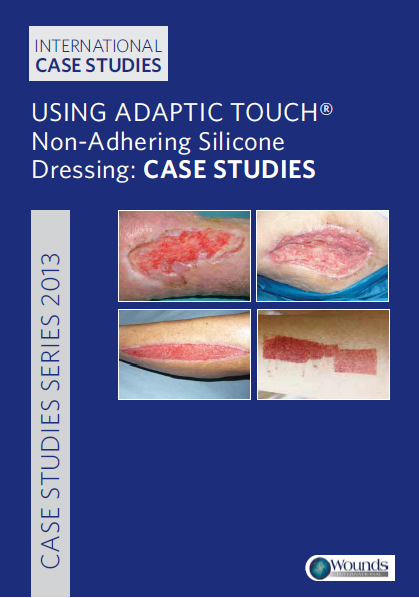
ADAPTIC TOUCH® Non-Adhering Silicone Dressing is a soft tack silicone dressing that has an advanced mesh design and is highly conformable. The mesh design minimises the risk of exudate pooling, maceration and secondary dressing adherance to the wound. Exudate is able to pass freely through the mesh. ADAPTIC TOUCH® is associated with patient comfort and […]
Understanding the financial benefits of optimising wellbeing in patients living with a wound
<p>Chronic wounds represent a major burden for patients, families, care givers, and healthcare organisations. Wounds cause pain, suffering, sepsis, infection, nausea, fatigue, depression, psychological disturbances, loss of function, loss of mobility, and personal financial cost. In many cases, wounds lead to amputation and even death.</p>
Optimising wellbeing in a palliative patient with an exuding, malodorous wound
<p>Although health care has become increasingly patient-centred over the past few decades, the focus of many clinicians carrying out wound care remains primarily on wound healing in the first instance, while patients may be more concerned by other factors (e.g. disguising unsightly strikethough). Clinicians must work collaboratively with patients to optimise wellbeing and outcomes. The […]
Wounds and wellbeing
<p>The theme of this issue of Wounds International is “wounds and wellbeing”. The articles included in the issue build on the work initiated by the international consensus document Optimising Wellbeing in People Living with a Wound – sponsored by Smith & Nephew – published in 2012. Although the concept is not new, the work involved […]
Wellbeing in wound care in Japan: Spreading a new concept
<p>The Japanese language is completely different from English and the word wellbeing is unfamiliar, even to healthcare professionals, except for those working in oncology. The concept of wellbeing focuses on positive aspects of health, such as independence and sense of satisfaction, contrary to the phrase “health-related quality of life”, which examines negative aspects. There is […]
Wellbeing in practice: Clinicians do have a role to play
<p>“Wellbeing“ – an individual's sense of how they feel about their life – is influenced by complex, multifaceted interactions of our physical, psychological, social, and spiritual/cultural beliefs; the elements that make us unique and human.</p>
How to… Ten top tips on compliance, concordance, and adherence
<p>Leg ulceration is a long-term condition that has a significant impact on the people living with it, as well as a high economic cost. Compliance and concordance are frequently highlighted as challenges to healing and understanding these terms can aid in the development of effective strategies to help patients successfully manage leg ulceration.</p>
Principles of compression in venous disease: a practitioner’s guide to treatment and prevention of venous leg ulcers
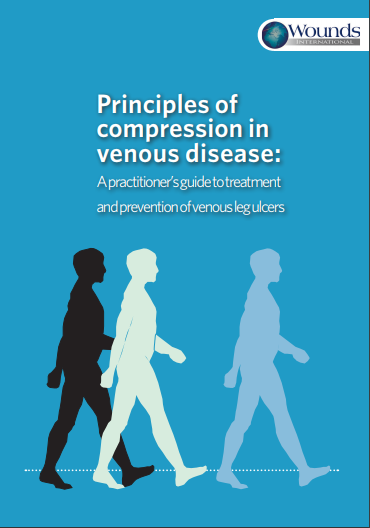
Compression therapy is the recognised treatment of choice for recurrent venous leg ulcers. Compression therapy systems include hosiery, tubular bandages and bandage systems comprising two or more components. These systems aim to provide graduated compression to the lower limb in order to improve venous return and to reduce oedema. The aim of this document is […]
Best practice guidelines: Wound management in diabetic foot ulcers
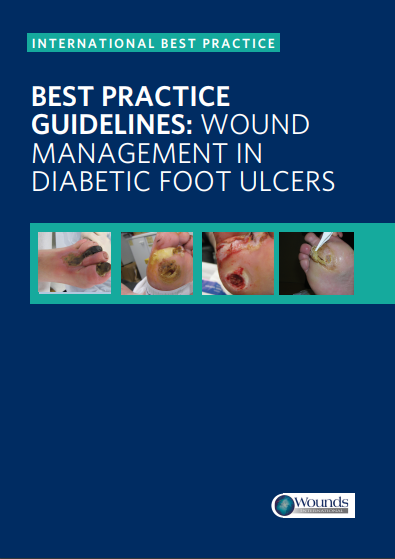
This document focuses on wound management best practice for diabetic foot ulcers (DFUs). It aims to offer specialists and non-specialists everywhere a practical, relevant clinical guide to appropriate decision making and effective wound healing in people presenting with a DFU. Supported by B Braun
Soft silicones Made Easy
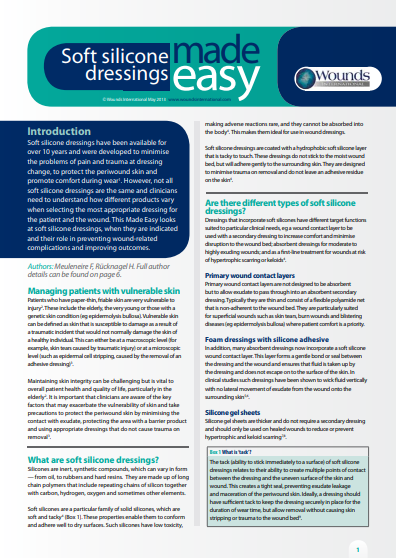
Soft silicone dressings have been available for over 10 years and were developed to minimise the problems of pain and trauma at dressing change, to protect the periwound skin and promote comfort during wear. However, not all soft silicone dressings are the same and clinicians need to understand how different products vary when selecting the […]
EPA Made Easy
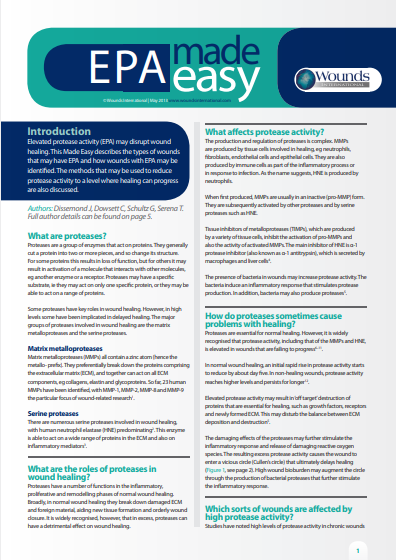
Elevated protease activity (EPA) may disrupt wound healing. This Made Easy describes the types of wounds that may have EPA and how wounds with EPA may be identified. The methods that may be used to reduce protease activity to a level where healing can progress are also discussed. Supported by WOUNDCHEKTM Laboratories
Understanding how honey impacts on wounds: an update on recent research findings
<p>Honey is a topical antimicrobial agent that has been used for millennia in wound care. Licensed wound care products containing medical-grade honey first became available in 1999 and are now widely used. Honey's therapeutic properties are largely attributed to its antimicrobial and anti-inflammatory activities. This review provides an insight into the laboratory evidence published in […]
Expert commentary: Understanding how honey impacts on wounds: an update on recent research findings
<p>On reading this article by Seckam and Cooper, we are reminded of both the traditional uses of honey in wound care over the past 2000 years, and the renewed interest in honey over the past two decades. This renewed interest has been prompted primarily by concerns around antibiotic resistance and the need for antimicrobial agents […]
Day in the life 4(1)
<p>This issue features Carmen Alba who is Nurse Manager, Functional Unit of Wounds, Hospital Clínico Universitario, Valencia, Spain.</p>
A cause for celebration
<p>A (slightly belated) happy new year to all our visitors. It is already March and we have plenty to celebrate and shout about with 2013 promising to be a most fortunate year for wound healing.</p>
Wound infection and diagnostics in practice: what is emerging?
<p>Wound infection unquestionably impairs healing, but many chronic wounds do not have high levels of planktonic bacteria as measured by standard clinical microbiology laboratory culturing methods.</p>
TIME for an update? Potential changes to wound assessment
<p>The concept of TIME has been discussed for 10 years and is widely accepted in clinical practice. However, since it was originally proposed in 2003, much has changed in both the fields of research and clinical practice. Therefore, it was felt necessary by the International Wound Infection Institute to provide an update to the TIME […]
Developments in wound management down under
<p>Wound infection. Those two words have been the source of much debate in recent years. Like many other countries, Australia has been swept up in the tide of products and strategies to minimise the burden of this ever-present scourge. The more cynical side of me sometimes wonders how any wound in the past ever healed […]
Innovations in topical antimicrobials
<p>The need for topical antimicrobials in the treatment of wounds is self-evident. Acute injuries will often be contaminated by the surroundings where the injury occurred and the risk of subsequent infection developing in these wounds is high, while chronic wounds will be contaminated, colonised, critically colonised, or infected due simply to their chronicity, and so […]
How to…Top tips on when to use silver dressings
<p>Silver dressings play an important role in wound management; indeed, silver has been used in the management of infected wounds for hundreds of years (Lo et al, 2008). Over time, the use of silver has changed dramatically, from the original application of silver wires directly into the wound, to the current vast range of dressings, […]
Using Promogran®/Promogran Prisma® on wounds with elevated protease activity: case studies
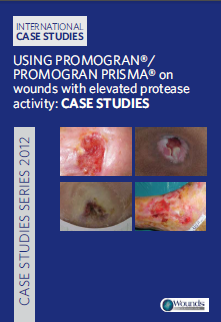
This document contains a series of case reports describing the use of PROMOGRAN® and PROMOGRAN PRISMA® (Systagenix) on patients with non-healing chronic wounds with elevated protease activity (EPA), assessed using a WOUNDCHEK™ Protease Status (Systagenix) test. All patients were treated for a minimum of four weeks and the decision to continue with PROMOGRAN®/PROMOGRAN PRISMA® was […]
The effective management of exudate in chronic wounds
<p>Moisture is essential to the normal healing process in acute wounds. In chronic wounds, however, exudate can be detrimental to wound healing. Wound exudate, particularly from chronic wounds, contains a cocktail of elements (cellular debris and enzymes), which can be very corrosive to the wound bed itself and the skin surrounding the wound. Careful holistic […]
Day in the life 3(4)
<p>This issue features Sara Holland, a Clinical Nurse at the Surgical Intensive Care Unit (SICU), Hospital of the University of Pennsylvania, USA. She is also currently enrolled in the Johns Hopkins Doctoral Programme, studying wounds in developing countries.</p>
Tales from the wound care circuit
<p>Suzie Calne explains how the various conferences, events and webcasts can enrinch the world of wounds</p>
Successful management of a venous leg ulcer using Durafiber dressings
<p>This case was included as part of a 10-patient clinical evaluation series to evaluate the acceptability of Durafiber(Smith & Nephew, a new highly absorbent dressing for medium-to-heavily exuding wounds. Clinicians from three centres in the UK were involved in the initial work, which showed that the dressing has the capability to contain high levels of […]
The ongoing development of a plasma-mediated bipolar radio-frequency ablation device for wound debridement
<p>The term 'debridement' was first used by French military surgeons in the 18th century and literally means ‘unbridling’. It was used to describe a treatment similar to fasciotomy for what would now be described as compartment syndrome[1]. This initial definition did not involve the removal of any tissue from the wound. Historically, there has been […]
Pulsed radio-frequency electromagnetic field (PEMF) therapy as an adjunct wound healing therapy
<p>Pulsed radio-frequency electromagnetic field (PEMF) is a non-ionising energy at the shortwave radio-frequency band of the electromagnetic spectrum that has achieved success in the healing of chronic wounds. This article examines how, why and when this treatment is appropriate.</p>
How to… Top tips for wound dressing selection
<p>There are a myriad of dressings available to manage chronic wounds and, as a result, it can be quite daunting for the clinician to make a decision as to the ‘best’ dressing for a given wound at a given time. Understanding the basic principles of wound management and coupling that with knowledge of the dressing […]
Leg ulcer update 3(4)
<p>Wounds International clinical updates present recent developments in the field of leg ulcers, pressure ulcers, skin integrity and diabetic foot, including the latest from associations, clinicians and industry. If you use an innovative technique in your practice that you would like us to feature in future issues, please email the editor at: [email protected]</p>
Managing a chronic wound in a heroin user
<p>Heroin is the most common illicit drug used intravenously. This article examines the ‘skin popping’ that occurs when using the drug, as well as the subsequent ulceration and scarring. Treatment and assessment is vital in order to increase compliance and wound healing in cases where heroin abuse is present.</p>


